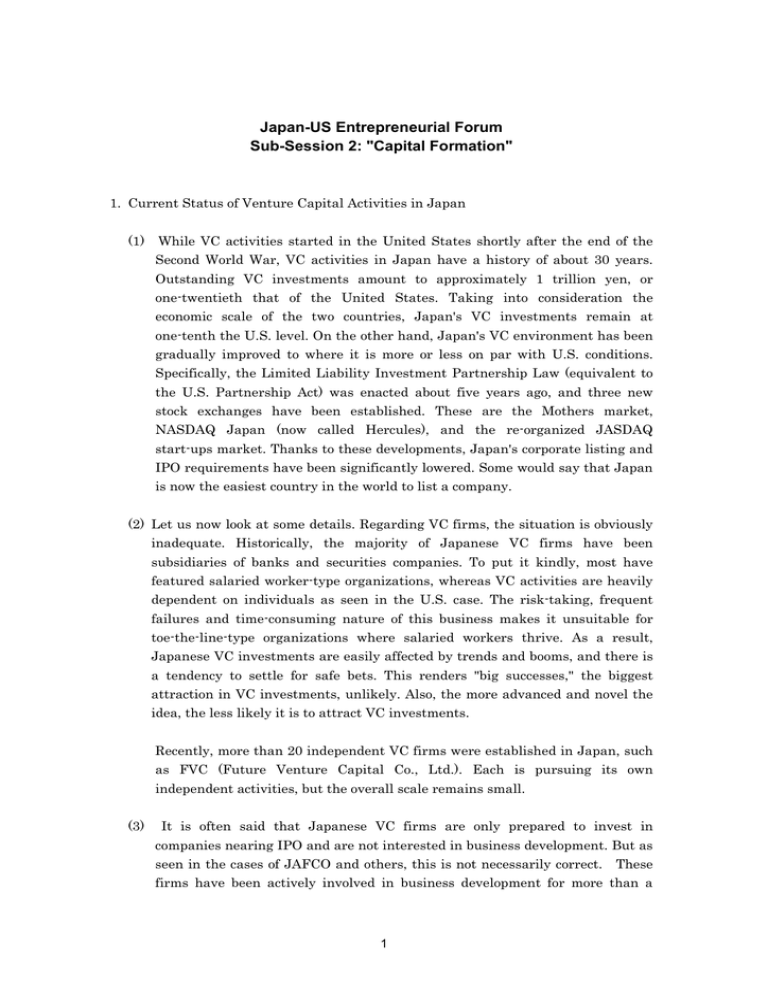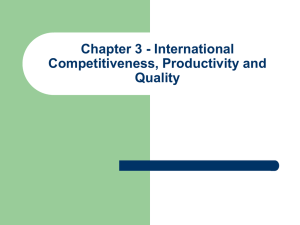Japan-US Entrepreneurial Forum Sub-Session 2: "Capital Formation"
advertisement

Japan-US Entrepreneurial Forum Sub-Session 2: "Capital Formation" 1. Current Status of Venture Capital Activities in Japan (1) While VC activities started in the United States shortly after the end of the Second World War, VC activities in Japan have a history of about 30 years. Outstanding VC investments amount to approximately 1 trillion yen, or one-twentieth that of the United States. Taking into consideration the economic scale of the two countries, Japan's VC investments remain at one-tenth the U.S. level. On the other hand, Japan's VC environment has been gradually improved to where it is more or less on par with U.S. conditions. Specifically, the Limited Liability Investment Partnership Law (equivalent to the U.S. Partnership Act) was enacted about five years ago, and three new stock exchanges have been established. These are the Mothers market, NASDAQ Japan (now called Hercules), and the re-organized JASDAQ start-ups market. Thanks to these developments, Japan's corporate listing and IPO requirements have been significantly lowered. Some would say that Japan is now the easiest country in the world to list a company. (2) Let us now look at some details. Regarding VC firms, the situation is obviously inadequate. Historically, the majority of Japanese VC firms have been subsidiaries of banks and securities companies. To put it kindly, most have featured salaried worker-type organizations, whereas VC activities are heavily dependent on individuals as seen in the U.S. case. The risk-taking, frequent failures and time-consuming nature of this business makes it unsuitable for toe-the-line-type organizations where salaried workers thrive. As a result, Japanese VC investments are easily affected by trends and booms, and there is a tendency to settle for safe bets. This renders "big successes," the biggest attraction in VC investments, unlikely. Also, the more advanced and novel the idea, the less likely it is to attract VC investments. Recently, more than 20 independent VC firms were established in Japan, such as FVC (Future Venture Capital Co., Ltd.). Each is pursuing its own independent activities, but the overall scale remains small. (3) It is often said that Japanese VC firms are only prepared to invest in companies nearing IPO and are not interested in business development. But as seen in the cases of JAFCO and others, this is not necessarily correct. These firms have been actively involved in business development for more than a 1 decade. However, unfortunately it is true that the training and development environment is not particularly good. Because of frequent personnel movements, there is a definite lack of continuity. Recently, FVC and an increasing number of other independent VC firms have adopted a hands-on approach and are saying that "business development is the essence of VC activities." Government agencies, such as the Japan Small and Medium Enterprise Corporation, and local government organizations have also realized that money is not the only requirement for start-up success. They too have started to engage in business development through the dispatch and placement of human resources. (4) Regarding the source of funds, in the United States, the majority of VC financing comes from pension funds. In Japan, hardly any pension money has found its way into VC funds. This is a particularly serious bottleneck for independent VC firms. While major advances have been achieved in deregulation and improvement of the environment in recent years, current conditions are not conducive to the flow of pension money to VC funds for the following reasons. Firstly, the pension fund’s traditional management is greatly damaged. Secondly, corporate pension funds are unwilling to take on new risks for fear of undermining the financial position of their parent companies. Thirdly, the volume of funds under management is halved as a growing number of corporate pension funds opt to surrender the "proxy portion" of pension assets to the government. To break through this dilemma, Japan's first investment-trust type VC fund was formed in 2001, allowing individuals to participate in VC funding with as little as 100,000 yen. The fund was listed on the Osaka Securities Exchange in January 2002 and has gained considerable liquidity. If several remaining problems can be resolved, this approach will stand as a very promising method, particularly for independent VC funds. 2. Current Status of Start-ups in Japan After the United States, Japan is the world's second largest economic country. While the Japanese economy appears to have developed along capitalist lines, a closer look reveals that in fact it has taken its own unique path. (1) Let me start with Japanese "limited liability company." The problem is Japanese start-ups and SMEs are rarely based on the principle of limited liability. The owner or president of the company basically must accept 2 "unlimited liability." Japanese companies are heavily dependent on bank borrowing to finance their activities, and when they borrow, the representative officer must accept responsibility for repayment. In other words, the president has to issue a personal guarantee. Given that many companies are under-capitalized and over-borrowed, when a company fails the president is often forced into personal bankruptcy. Thus, the president is made to accept very heavy responsibilities. The other side of the coin is that the president retains very strong powers and authority. That is, it is unrealistic to “control” or to “fire” the president when the president has virtually bet his entire life on the company. Further problems arise when company performance is suffering because of the president's poor management capacity. It may be clear to all that the president should be replaced, but where are you going to find a new president who is willing to tender his personal guarantee to save a failing company? (2) Another problem in Japan arises from difficulties in sales and marketing. Making a good product does not ensure that you can find buyers right away. Buyer decisions reflect a strong preference for major corporations, proven track records and established brand names. A start-up that is offering good quality products at low prices will nonetheless find it extremely difficult to sell its product. Many of Japan's giant electronic parts makers that emerged in the postwar period first went to the United States to establish their track records. Only then were they able to achieve success in the Japanese market. (3) While the Japanese environment for VC activities has greatly improved, the unfortunate truth is that start-ups are still far from being able to procure adequate funding when such funding is most needed. Bank lending remains wedded to the "land standard" which means that all loans must be fully collateralized. Consequently, start-ups with no significant assets find it extremely difficult to depend on bank borrowing to meet their needs for operating capital. Once a newly-formed company exhausts its own funds and the government subsidies that it has been able to receive, it is nearly impossible for it to get new loans. Certain policy-oriented government financial institutions become the only remaining hope. Japan occasionally experiences real-estate booms, IT booms, bio-technology booms and so on. When the country becomes excited about a boom industry, money will flow in, but not for long. VC firms may not be much help either, because the majority are subsidiaries of major corporate groups and few are prepared to take on large risks. 3. Future Directions for VC 3 The environment for VC in Japan is more or less well developed. What lies ahead is a competition of wits among VC firms. The question is often asked, "Does Japan have angels?" I can definitely say yes. For instance, FVC started out with just a hand full of individual shareholders, and the VC fund was financed by individual investors. FVC has invested in a total of 111 companies. In most cases, individual investors were there even before FVC. The problem is that because information on start-ups is not fully available, we do not yet have a system for attracting large numbers of people. The necessary infrastructure will have taken a giant step forward when investment-trust type VC funds, which I mentioned earlier, become common. Should pension money come pouring into VC funds within the next 18 to 24 months, the outstanding balance of Japan's VC investments could easily go from today's 1 trillion yen to 10 trillion yen to stand on par with the United States. When that happens, Japan will need greater mobility in human resources. "Companies are equal to their people." As such, both the VC firms doing the investing and the start-ups receiving the investments must be able to recruit high-quality human resources with future-oriented and positive attitudes. If that can be accomplished, Japan will certainly witness the birth of many new companies that will become the champions of growth in the new age. We are now seeing important reforms in the field of cooperation with universities. If this momentum can be advanced, Japan will have all that it needs in terms of human resources, financial resources and information. It is quite conceivable that this will lead to the birth of an area in Japan of comparable importance to Silicon Valley. FVC is headquartered in Kyoto, home to the largest number of Japanese Novel laureates, and an area which we believe holds out the best promising of developing into such a region. And here we are concentrating on the daily task of developing new start-ups. 4





